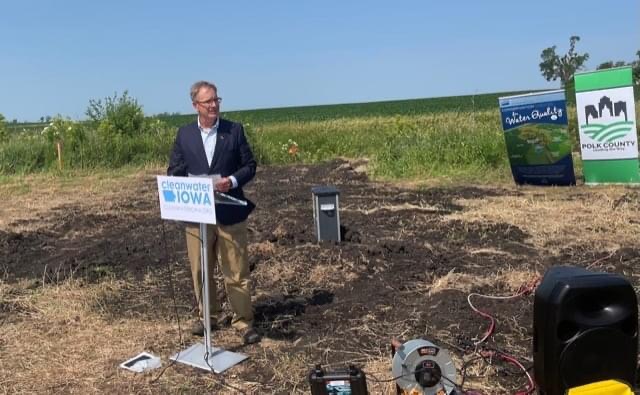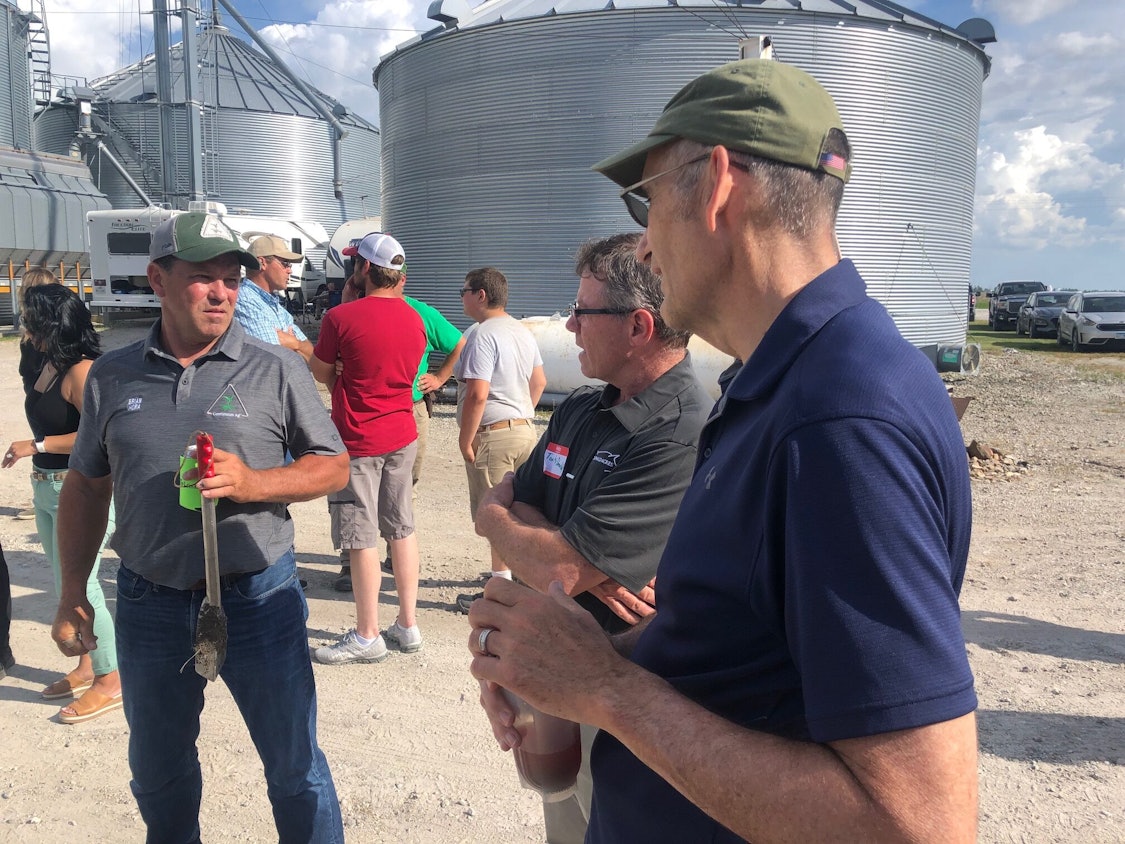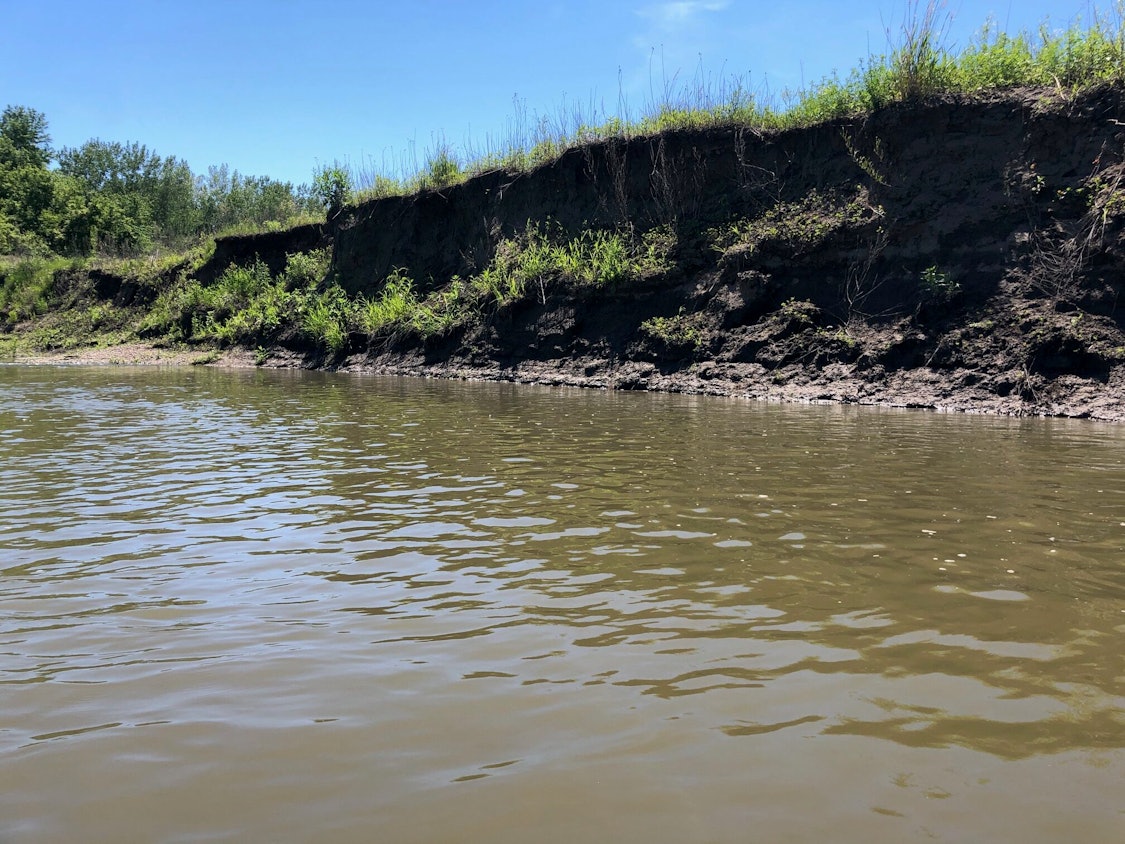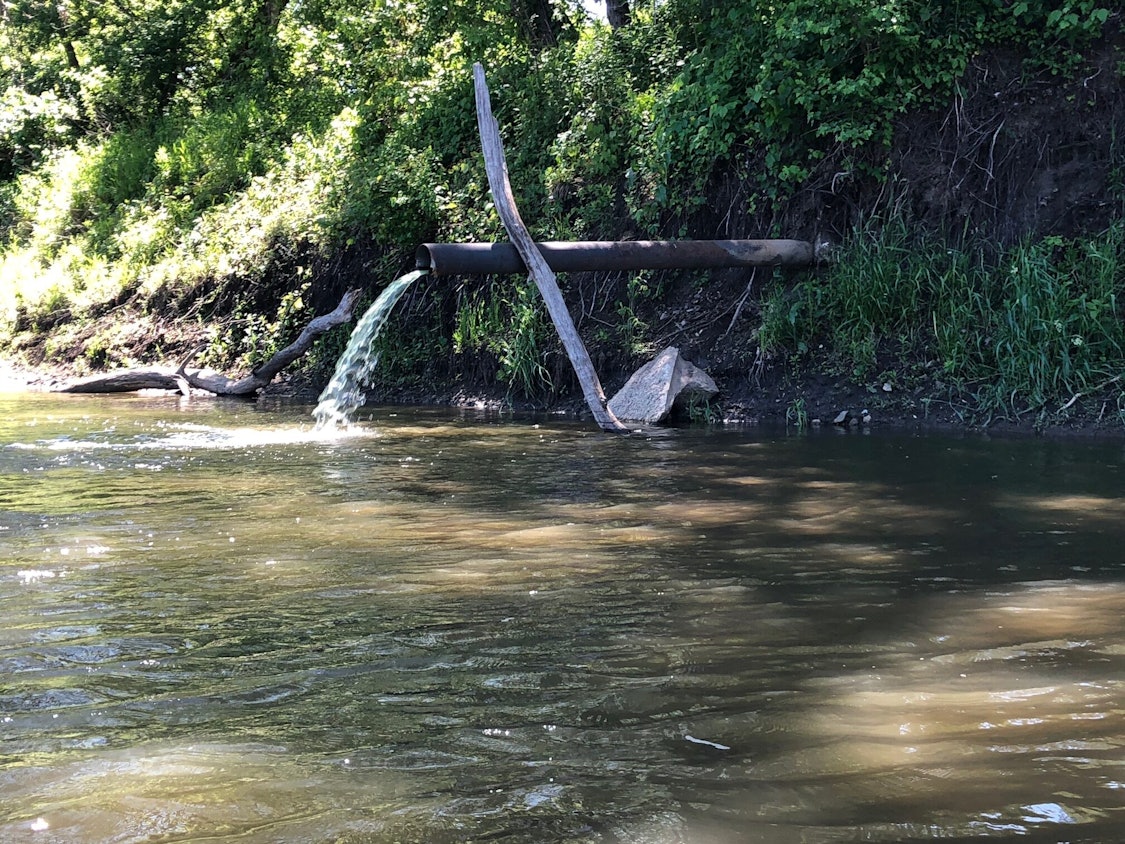John Norwood is a Polk County Soil and Water Commissioner.
These are my prepared remarks from the June 17 event announcing the Central Iowa Water Quality Infrastructure Project. I initiated a new bundled approach with the help of many others after attending an agricultural field day several years ago, where I wondered, how we could improve our effectiveness? Polk County, state, and federal government agencies are involved with the project; Iowa Secretary of Agriculture Mike Naig also spoke at Thursday’s kickoff.
The program is novel because Polk County is moving from single installations that used to require each landowner hiring a contractor, to batch installations of 50 and next year more than 100, using a general contractor bidding approach run by the county. The Soil and Water Conservation District actively targets sites using mapping technology and direct landowner outreach to secure participation, as opposed to waiting for landowners to come forward. The county, state, and municipal sources provided 100 percent cost share, and the installation is largely turnkey for the participants.
Secretary Naig, my fellow commissioners, partners, members of the media, distinguished guests, and ladies and gentlemen:
I appreciate the opportunity to join you all today to celebrate this innovative ground-breaking, systematic approach to getting things done. This strategy was born from a chance meeting with Charlie Schafer at a field day several years ago, me asking a lot of questions out of curiosity, followed by several coffee conversations, where together we began to reimagine a new way for delivering conservation infrastructure at scale. And then we widened the circle to include other key players in the conversation who built on the vision and drove it forward with the help of many others. Two of whom you will hear from in a few minutes.
First let me note that this type of locally led effort can be tailored whether we are delivering water quality infrastructure or soil health systems. If the strategies are scalable, turnkey, and targeted, the impact can be magnified many times. What we do in Polk County can be replicated in any of our other 98 counties, and as a “learning organization” that is how my District can support a larger effort. Stay tuned.
We are exploring systematic approaches to cover crops here in Polk County that might deliver 50,000 acres of cover crops by 2030 and 100,000 by 2035. I’d like to see us be the first Iowa county to establish targets and timelines for cover crops and no till practices and perhaps other counties and watershed groups can engage in some sort of friendly competition. Now let me shift gears to talk briefly about how this groundbreaking connects to a larger vision.
As an amateur historian, I believe the past can provide important information and instruction for our future. If only we pay attention to what’s gone before. What’s worked? What’s failed? Are we curious and brave enough to ask a lot of why questions which might bring ridicule but also lead to innovation?
Why did Soviet Premier Nikita Khrushchev come to Iowa in 1959? Why did China’s premier Jinping Xi, then as a middle level bureaucrat, and member of an agricultural delegation, come to Iowa in 1985? I’d say they came because they wanted to learn about agriculture from one of the world’s great centers of food production. And we are. If we measure ourselves principally by agricultural output: 23 million acres of corn and beans, 50 million hogs per year and so forth. North of $40 billion in economic output annually, second only to California. A top ten world producer if we were our own country.
You may ask what is my vision for Iowa agriculture? It’s not what I see today or what I heard yesterday at a soil health seminar up in Emmetsburg, or in Washington County last week, with experts talking about the depletion of our soils and the need to adopt regenerative practices which recognize the fundamental importance of soil biology to crop productivity, water management, carbon storage and so forth.
Talking about cover crops at Hora farm field day, Washington County
We have an unbalanced, unsustainable agricultural system, focused too narrowly on producing a few commodity outputs, because that is what is customary, subsidized, and Iowa farmers are good at it! Meanwhile our soils are being depleted at ten times the rate Mother Nature provides, and our drinking water, flood control reservoirs, and local road infrastructure, as county supervisors are telling me, are fouled all the way to the gulf with sediment and excess nutrients.
Turbidity from the South Raccoon near confluence with the North Raccoon at Van Meter
But what if we collectively adopt a new vision? An Iowa landscape that is productive, resilient, regenerative, diverse, vibrant, and in balance, using agricultural productivity, water management, water sovereignty, soil health and biologic activities, as principal measures of success. What is missing?
We start with a call for action, like President Kennedy did, when speaking at Rice University in 1962 about his desire for this nation to land a man on the moon and do other things. Not because it was easy he said, “but because they are hard, because that goal will serve to organize and measure the best of our energies and skills, because that challenge is one that we are willing to accept, one we are unwilling to postpone, and one which we intend to win.”
The soil and water challenges that we face here in Iowa and across the United States are hard. But the challenge is one I believe Iowa farmers and Iowans are willing to accept and ones that need to be faced now. It starts with setting ambitious targets and asking Iowans–and most Americans frankly have a stake since half the states drain to the Mississippi-Missouri River basin–to support these new goals with appropriate matching funds from Congress and the states.
River bank erosion
Let’s celebrate our collective heritage and outline a future for our agriculture that takes on these new challenges. It will require a shift of effort from “low to high gear,” as President Kennedy remarked on that September day, calling the moonshot effort “among the most important decisions” to be made during his presidency.
With climate change happening in real time before us, another drought now facing most of Iowa, rural and urban Iowans understand the importance of water. Water to produce corn and beans, water for livestock, water for human consumption, recreation, biological systems. As I too often hear, farmers and landowners are not the root cause of the problem. Most are wise stewards, rational and shrewd decision makers, but often with limited options. They can be on the front lines of new system led change if we can provide new options and opportunities, and listen for where we can improve, with empathy and humility.
And as this program demonstrates, we need a new approach that goes beyond the old way of one-at-a-time, every farmer figure it out for themselves. This is a slow road to nowhere fast. Instead, let’s introduce teamwork, collective action, and as important align local, state, and federal funding, including the $1.7 trillion infrastructure funding now being debated in Congress and the next Farm Bill, to support a broader range of outcomes we want to see on the land and in our rivers.
Iowa farmers are an ingenious, hardy, and dang optimistic lot, but they are not without many constraints, financial, technical, cultural and more. These need to be identified, acknowledged, and addressed.
Tile discharge into the Raccoon River
One key opportunity is using local farm leadership to help vision the modernization of our ag plumbing, water management and wetland filtration needs on some 14 million acres of tiled ground here in Iowa. The engineers support and execute on these locally led drainage district visions (some 3,600 statewide), and state, federal and other market resources are used to help implement the solutions so that these plumbing districts of today can become the water management districts of tomorrow.
This is what we celebrate today. Vision becoming action. Local learning, engaging landowners and operators in the effort, identifying and overcoming barriers, and scaling the impact.
In closing, it is my dream that today’s groundbreaking is just the start of a massive public-private effort to transform and modernize our agricultural systems to be in harmony with the diversity of our bucolic Iowa landscape. This is not government getting out of the way. It is innovative locally led government working with farmers, landowners, and stakeholders, helping to lead the way. It is investing billions to manage water and hold soil in place, principally in rural Iowa.
And 20 years from now, if I’m still here at age 76, it is my expectation that leaders from around the world will come to see our state-of-the art growing and management systems that provide for all that Mother Nature has in store for us. This will include ensuring we have abundant wildlife and strong, healthy biological systems that can sustain and enhance life in rural and urban Iowa, as well as life on earth.
Thank you.
-John M. Norwood
Top photo of John Norwood speaking at the June 17 event as well as the other photographs were provided by the author and published with permission.
June 17 event at Kurt Lehman’s farm near Alleman (Polk County):







1 Comment
I have thoughts about this interesting speech
If the bottom line is that taxpayers are to pay the costs for a massive agricultural transformation, like taxpayers are paying all the costs for the buffer blitz, then first, the reality must be faced that the costs will be huge. And while Iowa absolutely has as much right to federal infrastructure money as any other state, other states have expensive valid needs too, including their own natural-resource infrastructure transformations.
And federal funding is not infinite. I share the hope of many ag watchers that private industry will step in to provide a lot of funding for farm conservation. But for genuine progress to be made, that private funding will need to be tied to significant, effective, and monitored actions.
And ag interests should not be, via Congress, the only major deciders of how ag infrastructure money should be spent. This should not be a sweet deal in which ag interests retain all their current decision power and also get to drive a much bigger tractor, while taxpayers get to watch the driving, make the payments on the tractor, and provide the fuel.
Decisions about conservation transformation of drainage districts, for example, should be based on what is good for water, soil, and biota as determined by conservation experts, and those experts should make the rules that have to be followed by local engineers, local landowners, and ag groups. I say that as someone who has followed Iowa’s local and state drainage policies for decades, and have seen what current drainage priorities are.
In past decades of farm bills, conservation groups have never had even remotely-adequate input. The result has been farm bills that in some ways seemed designed to degrade soil and water and destroy biodiversity. Some farm conservation programs have harmed conservation. Organizations that have ecological health, not profit, as their primary concern, and have long-standing ecological expertise, should have a large say in how any large publicly-funded farm transformation program is designed.
Finally, while the drainage tile under Iowa farm fields belongs to the farmers and landowners who own and operate that land, Iowa water belongs to all Iowans. The Iowa Supreme Court may have narrowly dodged that reality for now, but it is reality nonetheless.
And the empathy and humility very appropriately recommended above need to be demonstrated by both sides. There has been a lot of wagon-circling, angry bluster, and defensiveness on the part of some ag people when it comes to water. Ag people need to listen to others just as much as others need to listen to them.
PrairieFan Tue 22 Jun 11:13 PM